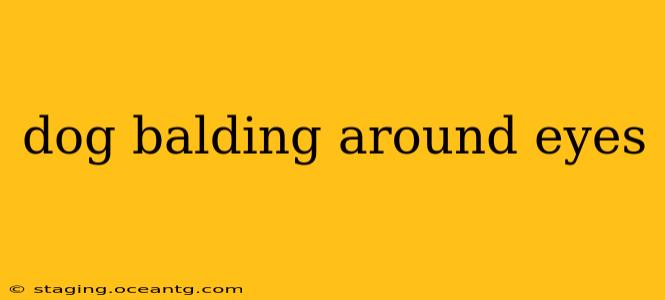Many dog owners notice their furry friends experiencing hair loss around their eyes, a condition that can be alarming but often has easily manageable causes. This comprehensive guide delves into the various reasons behind this issue, offering insights into diagnosis, treatment options, and when professional veterinary attention is crucial.
What Causes Hair Loss Around a Dog's Eyes?
Hair loss around the eyes in dogs, also known as periorbital alopecia, can stem from several factors, ranging from simple irritations to underlying health conditions. Understanding these potential causes is the first step in addressing the problem effectively.
Common Causes:
- Allergies: Environmental allergies (pollen, dust mites) or food allergies are frequent culprits. The constant itching and scratching associated with allergies can lead to significant hair loss around the sensitive eye area.
- Infection: Bacterial or fungal infections can irritate the skin, causing inflammation and hair loss. Yeast infections are particularly common in this area due to the warm, moist environment.
- Parasites: Fleas, mites, and ticks can cause intense itching and hair loss, often concentrated around the eyes and other sensitive body parts.
- Hormonal Imbalances: Certain hormonal disorders can manifest as hair loss. Cushing's disease, for example, can lead to thinning fur in various areas, including the face.
- Friction: Repeated rubbing of the eyes, perhaps due to eye discharge or irritation, can lead to localized hair loss.
- Autoimmune Diseases: In some cases, autoimmune disorders can attack the hair follicles, resulting in hair loss. Lupus is one example of such a disease.
- Nutritional Deficiencies: A lack of essential nutrients can sometimes contribute to poor coat health and hair loss.
Is My Dog's Eye Hair Loss a Sign of a Serious Problem?
This is a question many pet owners have. While many causes are relatively benign, some warrant immediate veterinary attention. Seek professional help if you notice:
- Sudden and significant hair loss: A rapid onset of baldness could indicate a more serious underlying condition.
- Skin lesions or redness: Inflammation, sores, or crusting around the bald patches may point to an infection or other skin problems.
- Other symptoms: If your dog is exhibiting other symptoms like lethargy, loss of appetite, fever, or changes in behavior, it’s crucial to consult a veterinarian.
- Persistent itching: Excessive scratching or rubbing that doesn't respond to home remedies warrants professional examination.
How is Dog Balding Around the Eyes Diagnosed?
Diagnosing the cause of periorbital alopecia requires a thorough examination by a veterinarian. They will likely conduct the following:
- Physical Examination: A complete physical exam to assess your dog's overall health.
- Skin Scraping and Cultures: To check for parasites like mites and fungal or bacterial infections.
- Blood Tests: To rule out hormonal imbalances or autoimmune diseases.
- Allergy Testing: To identify potential environmental or food allergens.
What are the Treatments for Dog Balding Around the Eyes?
Treatment will depend entirely on the underlying cause diagnosed by your veterinarian. Options may include:
- Medication: Anti-inflammatory drugs, antibiotics, antifungals, or corticosteroids depending on the diagnosis.
- Allergy Management: Dietary changes, environmental controls, and allergy medications.
- Parasite Treatment: Topical or oral medications to eliminate fleas, mites, or ticks.
- Topical Treatments: Creams or ointments to soothe irritated skin and promote hair regrowth.
Can I Use Human Products on My Dog's Eyes?
No. Human products are not formulated for dogs and can be toxic or harmful. Always use veterinarian-recommended products for your dog's treatment.
How Long Does it Take for Hair to Grow Back?
The time it takes for hair to regrow varies depending on the cause and the effectiveness of the treatment. With successful treatment of underlying issues, hair growth should gradually return.
What are Some Preventative Measures?
Regular grooming, a balanced diet, and prompt veterinary care for any skin or eye irritation can significantly reduce the risk of hair loss around the eyes. Maintaining a clean environment and preventing parasite infestations are also crucial preventative measures.
Remember, this information is for general knowledge and doesn't replace professional veterinary advice. If your dog is experiencing hair loss around its eyes, consulting a veterinarian is vital for accurate diagnosis and appropriate treatment. Early intervention can often lead to the best outcomes for your beloved pet.
